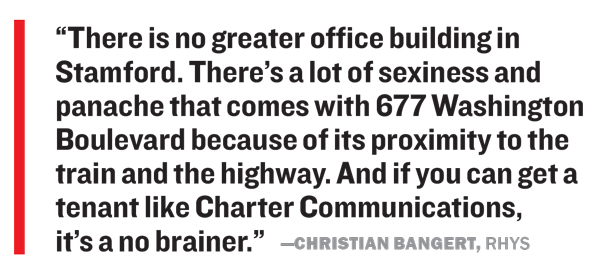Trending
Can new industry give Stamford’s office market the boost it needs?
The city is finally seeing some new tenants, but it may not be enough to salvage the suffering central business district

The clouds may be lifting — a bit —from the office market in Fairfield County. The mid-December sale of the former site of Swiss bank UBS in Stamford, coupled with Charter Communications’ commitment to move its headquarters to town and the promise of an infusion of smaller firms, is a bright patch amid what has been a dreary market.
The property that once housed UBS — a 700,000-square-foot structure that is Stamford’s largest vacant office space — sold for $33 million to Stamford Washington Investors, the same company that bought the property’s mortgage in April at a steep discount for $54 million.
Since UBS moved its remaining Stamford workers to an office across the street, where the Royal Bank of Scotland is also set up, the massive empty complex has been a blight on the city’s office market, which totals just 16 million square feet.
City officials hope the space, once home to the world’s largest trading floor, will now be easier to lease, since both the building and the land are owned by the same company.
“It’s always ideal to gain control of the ‘dirt’ of the property,” Christian Bangert, executive vice president of Stamford commercial real estate firm RHYS, told the Stamford Advocate. “Knowing the additional capital that will be needed to re-tenant the building and bring it up to modern office infrastructure levels, you really want to have as much control as possible and for as long as possible.”
Stamford has had a string of promising development news this year, including the introduction of new industries like technology to the area.
In October, Charter Communications announced plans to build a 500,000-square-foot headquarters at Gateway Harbor Point. The company, which provides broadband services, said the new building — slated to be completed in 2019 — will have direct access to the Stamford train station platform, providing employees with immediate access to both Metro-North and Amtrak service.
Local developer BLT was chosen to construct the 15-story facility at 406 Washington Boulevard, and there’s an option to expand the site into a two-building campus.
In addition, Henkel’s North American Consumer Goods headquarters opened on Elm Street in Stamford. The laundry, home and beauty care company relocated to the 190,000-square-foot facility from Scottsdale, Arizona.
City officials also note the arrival of smaller firms, such as the biotech company Sema4, which bills itself as a “health information company.”
 But even after steady improvement, office vacancy rates still ran at 26.8 percent in Stamford’s central business district and 28.3 percent elsewhere in the city during the third quarter, while the average rate in Fairfield County was 23.6 percent, according to Cushman & Wakefield data.
But even after steady improvement, office vacancy rates still ran at 26.8 percent in Stamford’s central business district and 28.3 percent elsewhere in the city during the third quarter, while the average rate in Fairfield County was 23.6 percent, according to Cushman & Wakefield data.
In Greenwich, the largest Connecticut town between Stamford and New York, vacancy rates were 15.9 percent in the central business district and 18.4 percent outside it. The strongest spot in the county was Fairfield/Southport, which posted only a 4.6 percent vacancy, while the worst market was in Trumbull, with vacancies running at a blistering 44.1 percent, according to Cushman.
Experts say that nearly a decade after the Great Recession, the region is still struggling to recover from its once-heavy reliance on the financial services industry. When the financial crisis hit, it caused severe damage to the local economy, which housed banks like UBS and other businesses.
When — and if -— the sale of the UBS property does result in re-tenanting the space, it would represent an important milestone in Stamford’s — and Fairfield’s — rebound.
But filling that space could be a big problem. Fairfied County still hasn’t figured out how to contend with a major trend in today’s office market: There aren’t a lot of companies looking to lease spaces as large as the which one vacated in the UBS building. Typically, leases are running 25,000, 50,000 and maybe 100,000 square feet, said Joseph McGee, vice president of public policy at the Business Council of Fairfield County.
Companies are looking for smaller footprints and flexible space to save money, according to experts.
“The real story we’re seeing is the value proposition,” McGee said. Smaller spaces are “a good value.”
Currently, average leasing prices are running around $32 a square foot in the county, according to McGee, down from a peak of about $37.50 in 2013. These are bargain rates compared to rents in Manhattan, which can be two to three times higher.
That discount is being used to lure companies to make the 30-mile move from New York City. Stamford has had a string of promising development news this year, and has attracted businesses in diverse industries, including technology.
McGee points to Sema4, the for-profit genetics arm spun off from Manhattan’s Mt. Sinai Hospital, which moved into a 28,000-square-foot building on the Stamford waterfront last fall. “They were very candid with us,” he noted. “They said, ‘now that we are a for-profit company, we have to be really aware of price differentials.’”
Another draw for Sema4 was Stamford’s close proximity to Manhattan via Metro-North, which means city-based employees can still get to work with a train ride of less than 50 minutes from Grand Central Terminal.
The easy reverse commute attracts firms with workers who aren’t ready to give up the bright lights of the big city.
That’s also helped change the dynamics of Greenwich’s central business district, said William Martin, an associate broker at Douglas Elliman Real Estate there.
Developers in Greenwich have been updating old offices or building new ones with the look and feel of sleek city offices to help bring companies north. And it’s working: Rates around the downtown railroad station have reached $95 a square foot in some cases. In contrast, a building at the top of Greenwich Avenue — less than a mile away, but out of easy walking distance from the train — will charge half as much.
The situation in Stamford is the same. Lease rates are about $51 a square foot on average around the train station, but they drop to about $25 in mid-Stamford, McGee said. Rates go back up to about $33 near the Merritt Parkway, since it offers easy access for driving commuters.
“The railroad station really has become the critical economic driver. That’s where you have the highest rents and most desirable neighborhoods,” McGee said. “That’s a big difference from 25 years ago, when buildings around the train station were surrounded by [barbed] wire.”




